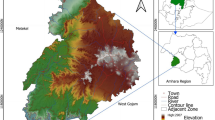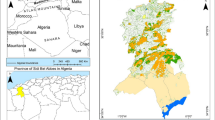Abstract
This study is to find the factors that affect the spatial change of forest land and purposefully predict the evolution trend of forest land space, so as to facilitate the rural planning work. The rural forest land situation in Zhangjiakou City of Hebei Province is analyzed, and the future evolution and development of forest space are predicted through analysis of correlation between the forest land influencing factors and the forest land productivity. Meanwhile, the multiple linear regression (MLR) prediction algorithm and support vector machine (SVM) are compared to obtain a more accurate prediction algorithm, which provides a strong basis for rural planning. The research results show that the annual rainfall and rainfall erosion have poor correlation with the spatial evolution of forest land relatively; while the average annual temperature is negatively correlated with annual rainfall and the rainfall erosivity. In addition, the soil erosion and terrain undulation of forest land have higher correlations with the rainfall erosivity due to abundant rainfall. The steeper the slope, the less human interference. What’s more, the prediction value of SVM is closer to the actual value with smaller absolute error, so it is more accurate than MLR. Therefore, research on the prediction algorithm provides new ideas for enriching the prediction algorithms of the spatial evolution trend, and is of great significance for improving the forest resource reserve capacity and meeting more forest resource demand in China. In addition, it can optimize the natural environmental quality, so it can be applied to rural planning and construction.






Similar content being viewed by others

References
Ling, C., Yunhua, An.: Research on rural spatial layout planning in beautiful rural construction. J Yangtze Univ (Nat Edn) 14(22), 26–27 (2017)
Rongping, Ye., Tao, W.: Research on the practice of beautiful rural planning and design. Constr Sci Technol 19, 91 (2017)
Wang, C., Lei, S., Elmore, A.J., et al.: Integrating temporal evolution with cellular automata for simulating land cover change. Remote Sens 11(3), 301 (2019)
Ochoa-Hueso, R., Piñeiro, J., Power, S.A.: Spatial distribution of fine root biomass in a remnant Eucalyptus tereticornis woodland in Eastern Australia. Plant Ecol 221(1), 55–62 (2020)
Navarro Cerrillo, R.M., Palacios Rodríguez, G., Clavero Rumbao, I., et al.: Modeling major rural land-use changes using the GIS-based cellular automata metronamica model: the case of Andalusia (Southern Spain). ISPRS Int J Geo-Inform 9(7), 458 (2020)
Zhang, C., Xu, Y.: Planning and policy of renewable energy utilization in a rural economic development zone. Polish J Environ Stud 29(5), 3915–3927 (2020)
Zhang, R., Cao, L., Shan, B., et al.: A method for connected vehicle trajectory prediction and collision warning algorithm based on V2V communication. Int J Crashworth 22(1), 15–25 (2017)
Wang, L.L., Chen, Z.G., Wu, J.: Vehicle trajectory prediction algorithm in vehicular network. Wireless Netw. 25(3), 1–14 (2018)
Kossobokov, V.G.: Testing an earthquake prediction algorithm: the 2016 New Zealand and Chile Earthquakes. Pure Appl Geophys 174(5), 1–10 (2017)
Wen, X., Cui, L., Yuan, F., et al.: Study on the utilization of inpatient services for middle-aged and elderly rural females in less developed regions of China. Int J Environ Res Public Health 17(2), 514 (2020)
Nishimoto, T., Mukaigawa, K., Tominaga, S., et al.: Serious injury prediction algorithm based on large-scale data and under-triage control. Accid Anal Prev 98, 266–276 (2017)
Zhu, S., Zong, X.: Fractal lossy hyperspectral image coding algorithm based on prediction. IEEE Access 5(99), 21250–21257 (2017)
Zhang, Y., Liu, D., Yu, J., et al.: EMA remaining useful life prediction with weighted bagging GPR algorithm. Microelectron Reliab 75, 253–263 (2017)
Man, G., Ling, C., Li, B., et al.: A link prediction algorithm based on low-rank matrix completion. Appl Intell 48(1), 4531–4550 (2018)
Ebrahimi, M.A., Khoshtaghaza, M.H., Minaei, S., et al.: Vision-based pest detection based on SVM classification method. Comput Electron Agric 137, 52–58 (2017)
Yin, Y., Xu, D., Wang, X., et al.: Online state-based structured SVM combined with incremental PCA for Robust visual tracking. IEEE Trans Cybern 45(9), 1988–2000 (2017)
Wu, D., Rui, Y., Zhao, H., et al.: A novel intelligent diagnosis method using optimal LS-SVM with improved PSO algorithm. Softw Comput 2–4, 1–18 (2017)
Ng, K.Y., Awang, N.: Multiple linear regression and regression with time series error models in forecasting PM10 concentrations in Peninsular Malaysia. Environ Monit Assess 190(2), 63 (2018)
Stokes, C., Masselink, G., Revie, M., et al.: Application of multiple linear regression and Bayesian belief network approaches to model life risk to beach users in the UK. Ocean Coast Manag 139, 12–23 (2017)
Sharma, V., Kumar, R.: Dating of ballpoint pen writing inks via spectroscopic and multiple linear regression analysis: a novel approach. Microchem. J. 134, 104–113 (2017)
Sang, K.P., Moon, H.J., Min, K.C., et al.: Application of a multiple linear regression and an artificial neural network model for the heating performance analysis and hourly prediction of a large-scale ground source heat pump system. Energy Build. 165, 206–215 (2018)
Pahlavan, H.A., Zahraie, B., Nasseri, M., et al.: Improvement of multiple linear regression method for statistical downscaling of monthly precipitation. Int. J. Environ. Sci. Technol. 15(9), 1–16 (2017)
Watagoda, L. C. R. P., Olive, D.J.: Bootstrapping multiple linear regression after variable selection. Statistical Papers, pp. 1–20 (2019)
Martínez-Filgueira, X., Peón, D., López-Iglesias, E.: Intra-rural divides and regional planning: an analysis of a traditional emigration region (Galicia, Spain). Eur. Plan. Stud. 25(7), 1–19 (2017)
Chen, Y., Zijun, F., Siren, L.: The planning of rural public space influenced by the cultural tourism industry. J. Landsc. Res. 10(4), 48–50 (2018)
Alfaro, J.F., Miller, S., Johnson, J.X., et al.: Improving rural electricity system planning: an agent-based model for stakeholder engagement and decision making. Energy Policy 101, 317–331 (2017)
Acknowledgement
Supported by the Stragegic Priority Research Program of the Chinese Academy of Sciences, Grant No. XDA19040501.
Author information
Authors and Affiliations
Corresponding author
Additional information
Publisher's Note
Springer Nature remains neutral with regard to jurisdictional claims in published maps and institutional affiliations.
Rights and permissions
About this article
Cite this article
Jiang, X., Zhang, N., Huang, J. et al. Analysis of prediction algorithm for forest land spatial evolution trend in rural planning. Cluster Comput 24, 195–203 (2021). https://doi.org/10.1007/s10586-020-03227-7
Received:
Revised:
Accepted:
Published:
Issue Date:
DOI: https://doi.org/10.1007/s10586-020-03227-7



